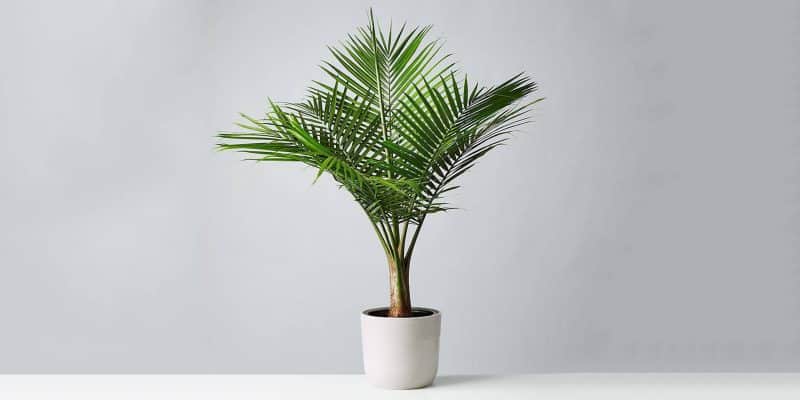Bow hello to the Majesty Palm (Ravenea rivularis), also known as the Majestic Palm.
Is Majesty Palm easy on the eyes? You bet. But it’s also pretty easy to care for, too. With its graceful feathery fronds and stately demeanor, this slow grower makes the perfect kingly (or queenly) houseplant.
Hailing from the island of Madagascar, Majesty Palms are used to basking in the warmth and humidity of their tropical and subtropical habitats. But the good news is, they can adapt quite well to life indoors, too.
We’ll take you take you through everything you need to know about Majesty Palm care outdoors and indoors, from curating the right planting and propagating to mastering the art of watering and humidity.
Table of Contents
Majesty Palm Care Guide
History, Habitat, and Characteristics
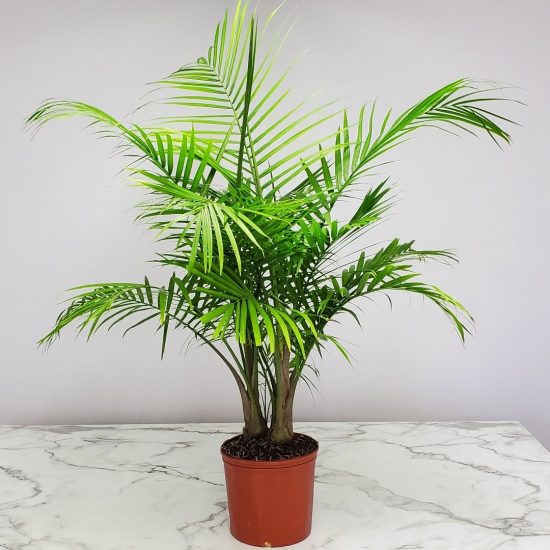
Majesty Palms share the spotlight with various other palm species like the slow-growing areca palm, parlor palm, and kentia palm. Naturally found swaying near riverbanks and stream beds in Madagascar, Majesty Palms really know how to live it up in tropical and subtropical climates.
Back in the 1980s, the United States and Europe got wind of this palm’s charming presence, and (not surprisingly) it became a must-have addition to homes and gardens alike.
The quality that sets the Majesty Palm apart from other houseplants and palm species is its unique appearance, with arching green fronds gracefully reaching out from a cluster of stems.
While these majestic (get it?!) plants can reach heights of up to 30 feet in their natural habitat, keeping them indoors and limiting their root space helps maintain a more manageable height of 6-10 feet. They usually grow about one foot annually.
While outdoor Majesty Palms can bloom with white flowers that then produce red fruit, indoor palms rarely do.
Light
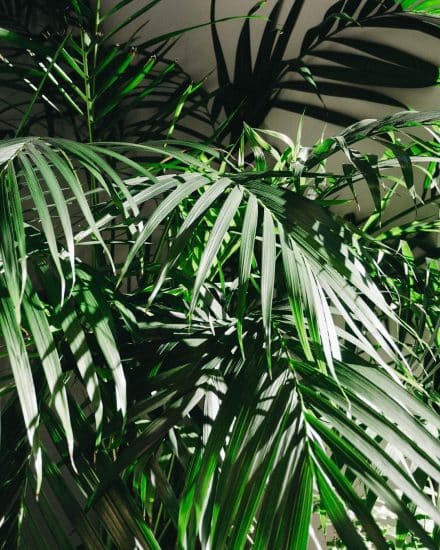
Majesty palms, also known as Ravenea rivularis, are tropical plants that thrive in bright and indirect light.
When a majesty palm doesn’t receive enough light, its leaves begin to droop and turn yellow, signaling that the plant is struggling to photosynthesize. Additionally, you may notice slow or no growth, as the palm can’t properly fuel its development.
In some cases, the plant may also appear to be stretching, which is another sign of inadequate light. This may be a good time to move it closer to a sunny window.
On the other hand, a majesty palm exposed to excessive direct light may suffer from scorched leaves and sunburn spots, which are small, round, brown patches on the leaves. It’s essential to keep in mind that while these palms love light, you may need to use a sheer curtain to filter direct sun.
Water
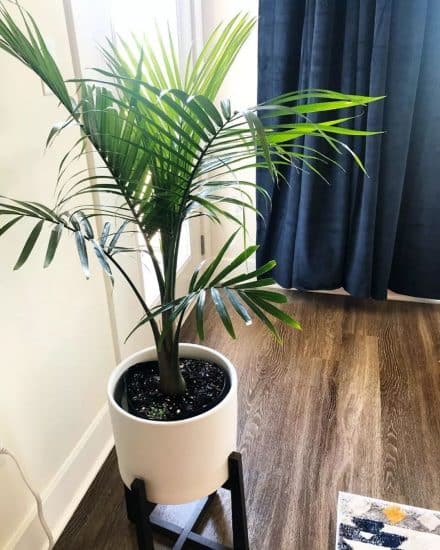
Ravenea rivularis comes from the lush land of Madagascar, where it loves to soak up moisture near rivers and streams. So, to help your indoor palm tree feel right at home, you’ll want to water regularly to recreate those abundant conditions.
You should aim for keeping the potting media evenly moist but not soggy. During the growing season, consider watering your Majesty Palm daily, or every 5-7 days. When it gets colder, cut back to every 10-14 days.
To figure out when your palm tree needs a drink, stick your finger about an inch into the soil — if it feels dry, it’s time to water! Of course, you’ll need to keep an eye on your palm’s needs and the humidity in your space to find the perfect watering schedule.
So, what happens when your Majesty Palm isn’t getting enough water? Well, you’ll see the leaf tips turn brown and become crispy, droopy, and wilted. Eventually, the entire frond will suffer. You definitely don’t want that!
The key is to make sure you’re giving your plant a good soak so that the water reaches the roots. If things get really dry, you might need to dunk the root ball in a bucket of water for a few hours to help it bounce back.
On the flip side, if your palm is swimming in water, you might notice an overall decline in its health, and its leaves turn yellow. Plus, excess water can cause root rot and a musty smell from the soil. So, if you see yellowing fronds and think you’re being too generous with the watering can, cut back and ensure your plant is in a well-draining, fast-draining soil.
Temperature and Humidity
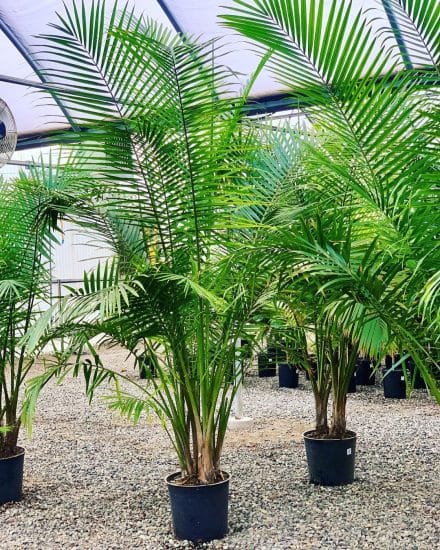
Majesty Palms prefer temperatures between 65°F-80°F (18°C-27°C) during the day and no lower than 55°F (13°C) at night. To achieve these conditions indoors, place your palm tree in a well-lit area, away from drafts, air conditioners, and heating vents to avoid sudden temperature changes.
Signs that the temperature is too high include scorched leaves and wilted fronds. Conversely, an indication if temperatures that have dropped too, you’ll see yellowing leaves, withering fronds, and slowed or halted growth.
Humidity is another important aspect of your majesty palm’s care. Though these plants prefer humidity levels of 50% or higher, they can adapt to average household humidity conditions. To maintain the desired indoor humidity levels, use a humidifier or pebble tray, or mist your plant daily, particularly in dry winter climates.
Signs of too little humidity include brown, curled, or crispy leaf edges, while too much humidity can result in wilted leaves and fungal or bacterial growth.
Our tips:
- Keep your Majestic Palm away from drafts, air conditioners, and heating vents to avoid sudden temperature changes.
- Use a humidifier or mist your palm daily in dry winter climates to maintain humidity levels.
- Group your Majestic Palm with other humidity-loving plants to increase the overall humidity.
- Monitor temperature and humidity levels with a hygrometer to help maintain the ideal conditions for your Majestic Palm.
Soil and Planting
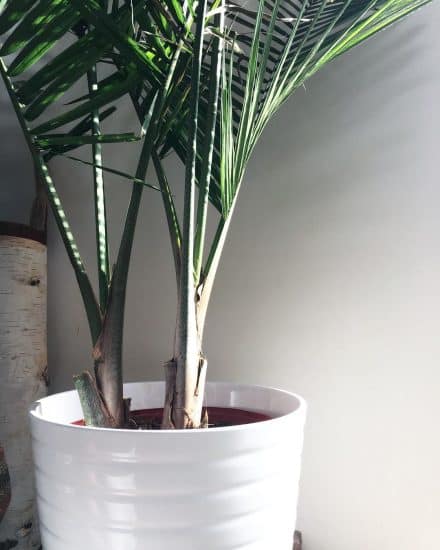
Since Majestic Palms are acid-loving plants, their ideal soil mixture is a combination of standard potting mix with extra peat. This ensures good drainage and slightly acidic pH levels between 6.0 and 7.0, creating the perfect environment for your tropical palm to flourish.
Choosing the wrong potting combination for your Majesty Palm can lead to a range of issues, like stunted growth, yellowing leaves, or the presence of pests like mold or gnats. Make sure it’s just a tad acidic and drains well!
Fertilizer
Apply a balanced, slow-release granular fertilizer or a water-soluble liquid fertilizer diluted to half strength once every 4-6 weeks during the growing season.
Over-fertilizing can cause problems like leaf burn, brown or yellow spots, or leaf drop. If you suspect your Majesty Palm has been over-fertilized, stop applying fertilizer and flush the soil by watering thoroughly, allowing excess water to drain out. After that, refrain from fertilizing for a few months before reintroducing it cautiously.
Repotting
Majesty Palm is a slow grower, and repotting may not be necessary for several years. However, if the palm has outgrown its container, if its roots appear to be circling the pot, or if you notice signs of poor soil, you should consider repotting.
Palm trees prefer not to be root-bound, so choose a new pot that’s 1-2 inches larger in diameter than the previous one. Ensure the new pot has drainage holes and is filled with an appropriate soil mixture to help your Majesty Palm grow.
Propagation
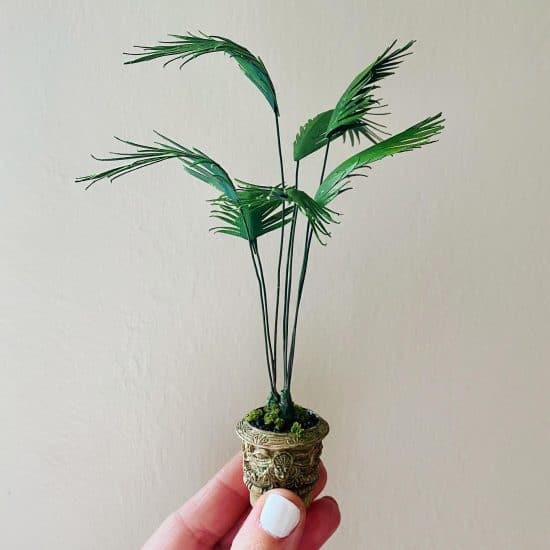
If you adore your Majesty Palm or Ravenea rivularis (and who wouldn’t?) you might be thinking about propagating it. Although it’s common to grow Majesty Palms from seeds, why not try the pup propagation method?
Separating those little “babies” or “pups” from the mother plant is best done during repotting to minimize stress on your leafy friend.
Propagating Majesty Palm by pups:
- Pick the spring or early summer: Propagate when your Majesty Palm is actively growing and may need repotting. Search for healthy, green offshoots sprouting from the soil, as these are your pups.
- Gently remove the entire parent plant: Loosen the dirt around the pot’s edges and carefully lift the palm, avoiding broken roots or crushed pups.
- Inspect the root ball: Locate the pups connected to the mother plant. Massage the root ball gently to untangle the roots and separate the pups. For best results, choose a healthy pup, around 6 inches tall, with a few leaves.
- Gather your materials: Before beginning, clean your cutting knife or shears with rubbing alcohol or a bleach solution to remove germs. Select pots with drainage holes and a well-draining potting mix.
- Remove dead or damaged leaves from the pup: Use your sterilized cutting tool for this task. Allow the cut end of the pup to dry for a day or two, forming a callus to prevent rot and infection. You can also trim the roots if necessary.
- Place your pup into a pot: Use a fast-draining potting mix to ensure the pup is neither too deep nor too shallow; the base of the stems should be slightly above the soil’s surface.
- Water the newly planted pup: In addition to consistent water, provide your plant with a diluted fertilizer solution for a healthy start. Set the potted pup in a bright spot with indirect sunlight and maintain moist soil.
Our tips:
- Propagate during repotting to minimize stress on the mother plant.
- Massaging the root ball helps untangle roots without causing damage.
- Be patient, as root development for new plants takes time, and keep a watchful eye on your baby palm.
Common Issues
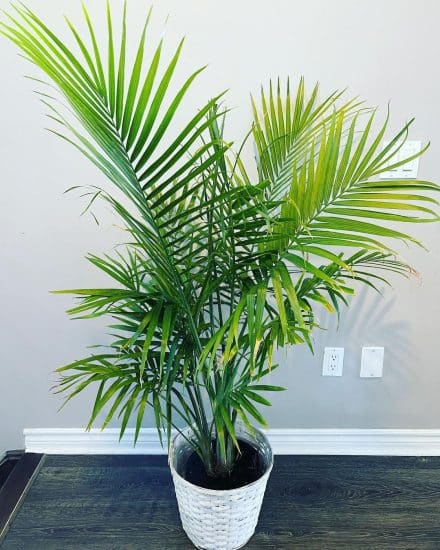
Yellowing Leaves
Sometimes the yellowing leaves look streaky, and other times, they turn fully yellow. This typically happens when your plant is underwatered, not getting enough bright light, or feeling a bit starved for nutrients.
Fear not! First, let’s make sure it’s getting the right amount of water, without drowning it (root rot, anyone?). Then, place it in a cozy spot with bright, indirect sunlight. Check your thermostat is between 65-75°F; this is the sweet spot for indoor temperatures. Lastly, treat your palm to a delicious, balanced, slow-release fertilizer to help with nutrient absorption.
Brown Leaves
If your Majesty Palm leaves turn brown, think of this as a little SOS from your palm. It could be due to overwatering, underwatering, too much salt in the soil, or even pesky pests or diseases.
Start by examining your watering habits. Overwatering? Ease up on the H2O and ensure proper drainage. Underwatering? Show your palm some love by watering more frequently, letting just the top layer of the potting mix dry out between drinks. If you’ve got a salt problem from too much fertilizer, flush the soil generously to wash away the excess salts.
Pests and Diseases
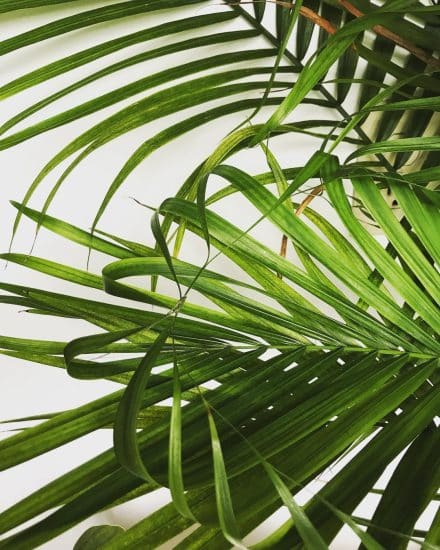
Root Rot
Root rot occurs when the roots of the plant are exposed to excessive moisture, causing them to decay.
To identify root rot, look for yellowing and wilting leaves, a foul smell from the plant’s base, and mushy, dark, and unhealthy roots when the plant is removed from its pot.
If you’ve identified root rot in your majesty palm, you can save your plant with the following steps:
- Remove the plant from its pot and gently wash away the soil from the roots to get a clear view of the affected area.
- Using a clean pair of pruning shears, trim away the affected roots. Be sure to sanitize your shears afterward to prevent the spreading of infection.
- Let the plant’s roots dry out for a few hours. This will allow the plant to heal and minimize the risk of spreading rot.
- Repot the plant in fresh, well-draining soil. Ensure that the new pot has adequate drainage to help prevent future occurrences of root rot.
To keep root rot at bay, always use a well-draining soil mix for your majesty palm Avoid overwatering your plant – keep the soil evenly moist but not soaking wet. And don’t forget to empty the saucer under the pot to prevent standing water.
Spider Mites
Spider mites are tiny pests that can infest indoor plants like the majesty palm. Although small, they can cause significant damage when their populations grow.
Be on the lookout for these symptoms of spider mite infestations on your palm:
- Fine webbing on the leaves and stems
- Tiny yellow or brown spots on the foliage
- Overall lackluster appearance and poor growth
If you suspect a spider mite infestation, isolate the affected palm from other plants to prevent spreading. Wipe down the leaves and stems using a damp cloth or paper towel to remove as many mites as possible. Finally, treat the plant with insecticidal soap or neem oil. Apply according to the product’s instructions and treat as necessary to ensure complete eradication.
To prevent future infestations, regularly inspect your majesty palm for telltale bug signs, since early detection is crucial. Maintain a consistent watering schedule, as mites thrive in dry conditions. Occasionally mist your plant with water, since spider mites hate moisture!
Conclusion
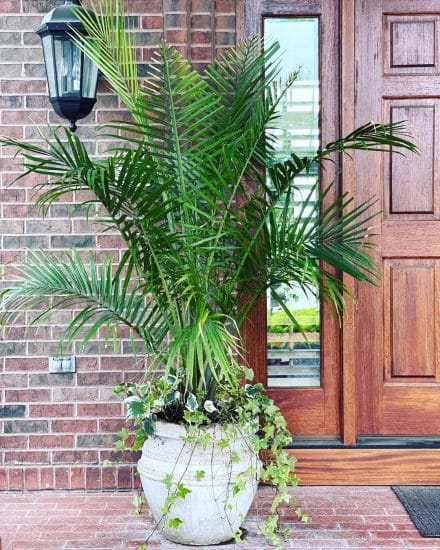
That’s a wrap for our Majesty Palm care guide! You’re now equipped with all the knowledge you need to bring a touch of the tropics into your home with the graceful Ravenea rivularis.
Majesty Palm care summary:
- Your palm tree grows best in bright, indirect light.
- Maintain a consistent watering schedule, keeping the soil moist but not waterlogged.
- Use well-draining soil with an ideal pH of 6.0 to 7.0. Regularly flush out wet areas where salt may build up.
- Keep humidity levels high and remember to mist your palm to maintain its vibrant appearance. High humidity will also help prevent browning leaves.
- Be on the lookout for pests and diseases, and address any issues promptly.
With focused care and attention, your Majesty Palm will transform your living space into a lush, tropical paradise. If you found our guide helpful, don’t forget to share it with friends and fellow plant lovers. Feel free to reach out if you have any questions — we’re always here to help.
Happy palm planting!
FAQ
How much sun do Majesty Palms need?

A Majesty Palm (Ravenea rivularis) thrives in bright light that’s also indirect. While it can tolerate lower light conditions, its growth may slow down, and the fronds might lose their vibrant green color. Keep your Majesty Palm near an east-facing window to provide plenty of indirect light, or a west- or south-facing window filtered by a curtain.
Should I cut the brown tips off my Majesty Palm?
You can trim the brown tips off your Majesty Palm to improve its appearance. Use clean, sharp scissors or pruning shears to cut the brown tips. Make sure to cut at an angle, following the shape of the leaf, to maintain a natural look. Removing the brown tips will not harm the plant and can help it focus its energy on new growth.
Can I leave my Majesty Palm outside?
Majesty Palms can be kept outside, but it’s important to ensure that the outdoor conditions meet their requirements. They prefer temperatures between 65°F-80°F (18-27°C) during the day and no lower than 55°F (13°C) at night. If you live in a suitable climate, you can leave your palm outside, but be prepared to bring your Majesty Palm indoors to protect it from cold or harsh weather, strong winds, and too much sunlight (direct sunlight, to be specific).
How does caring for an outdoor Majesty Palm differ from an indoor plant?
There are a few key differences:
- Outdoor Majesty Palms may need more frequent watering, especially during the hot summer months. Check the soil regularly to ensure it stays consistently moist but not waterlogged.
- Ensure your outdoor Majesty Palm is in a location with bright filtered light and protection from intense direct sunlight and strong winds.
- Monitor the temperature. Your Majesty Palm is better off grown indoors if the weather turns too cold, as they are sensitive to frost and cold temperatures. Just be cautious about dry air indoors and make sure to provide it with high humidity.
- Outdoor Ravenea rivularis plants may be more susceptible to pests and diseases, so regularly inspect your Majesty Palm and treat any issues as soon as possible.
Sources
- https://www.palmpedia.net/wiki/index.php/R._rivularis
- https://selectree.calpoly.edu/tree-detail/1687

